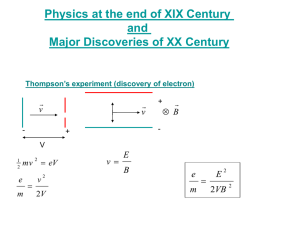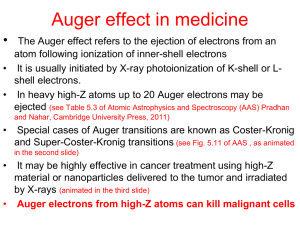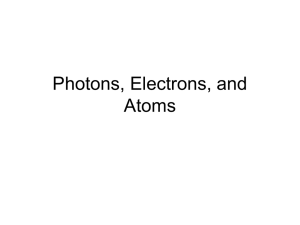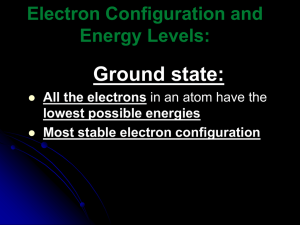Worksheet - X-rays Solution
advertisement
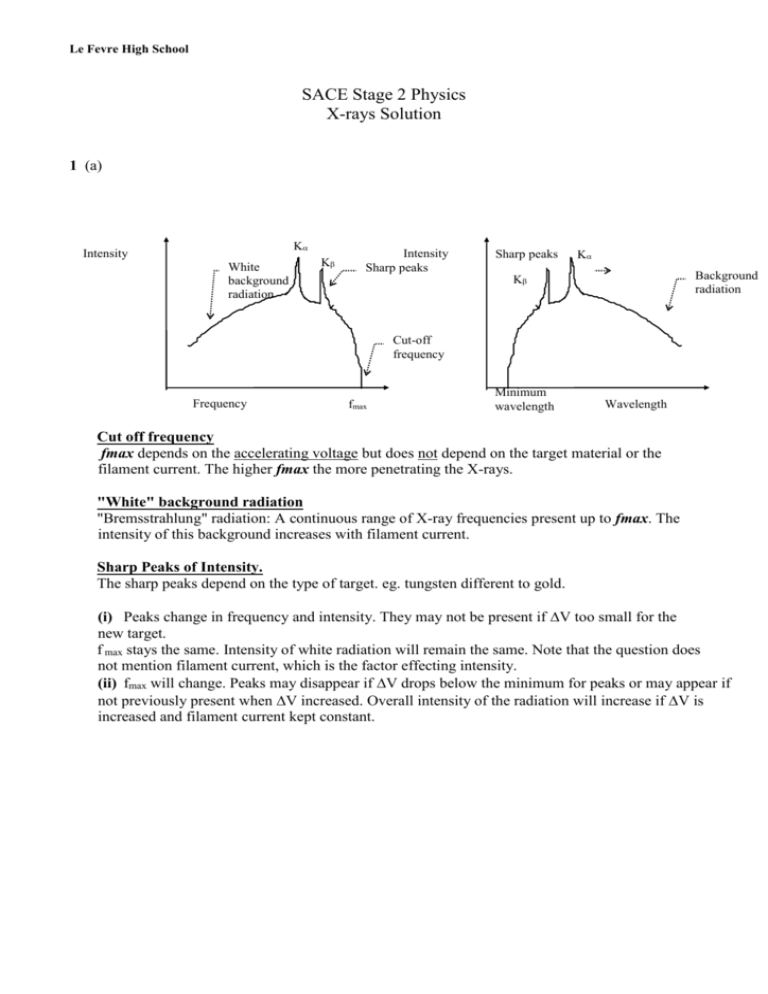
Le Fevre High School SACE Stage 2 Physics X-rays Solution 1 (a) K Intensity White background radiation K Intensity Sharp peaks Sharp peaks K Background radiation K Cut-off frequency Frequency fmax Minimum wavelength Wavelength Cut off frequency fmax depends on the accelerating voltage but does not depend on the target material or the filament current. The higher fmax the more penetrating the X-rays. "White" background radiation "Bremsstrahlung" radiation: A continuous range of X-ray frequencies present up to fmax. The intensity of this background increases with filament current. Sharp Peaks of Intensity. The sharp peaks depend on the type of target. eg. tungsten different to gold. (i) Peaks change in frequency and intensity. They may not be present if V too small for the new target. f max stays the same. Intensity of white radiation will remain the same. Note that the question does not mention filament current, which is the factor effecting intensity. (ii) fmax will change. Peaks may disappear if V drops below the minimum for peaks or may appear if not previously present when V increased. Overall intensity of the radiation will increase if V is increased and filament current kept constant. Le Fevre High School (b) K of electrons = W on electrons by E field 1 i.e.. mv2 = q V 2 2qV v2 = m 2qV Therefore v = m 2 x 1.6 x 10 19 x 48 x 10 3 9.11 x 10 31 = 1.3 x 108 m s-1 = 2 K of an electron hitting the target = work done on it by field = q V = 1.6 x 10-19 x 66,000 J When producing an X-ray of maximum frequency, all this energy becomes converted to a single photon of radiation, of energy hf. E 66000 x 1.6 x 10 19 i.e.. f = = h 6.63 x 10 34 = 1.6 x 1019 Hz 3. (i). Increasing the filament current in a hot-cathode X-ray tube will raise the temperature of the filament, and so cause a greater number of electrons to be emitted per second. Hence, a greater quantity of X-radiation ( more photons) results, but with same wavelength (frequency) distribution. (ii). Increasing the applied voltage will increase the energy gained by each electron as it moves from filament to target and so on striking the target it will give up more energy: and therefore produce photons of greater energy content, that is, of higher frequency, hence X-ray is of shorter wavelength and greater penetrating power. The minimum voltage is obtained by assuming that for some electrons striking the target, ALL their K is converted into a photon of radiation. Now energy of photon = hf. = hc/, (from c = f) Now energy of electron is that given to it by field (approx.) hc E = qV = hc Therefore Vmin = q = 6.63 x 10 34 x 3 x 10 8 1.0 x 10 11 x 1.6 x 10 19 = 124312.5 volt Le Fevre High School 4 (a) copper anode (+) X rays cathode(-) Collimating Slit cooling fins heater 6 V AC electrons tungsten insert 20,000 - 200,000 V AC evacuated glass container step up transformer 240 V AC (b) (i) Filament: heated wire produces thermal electrons, these electrons are refined to a narrow beam by the collimating slit. (ii) Target: a dense high melting point metal. When high energy electrons interact with this metal, they are decelerated and lose kinetic energy as either heat or a high energy X-ray photon. (iii) Theory considers that during the electron collisions with the nuclei in the target the electrons undergo accelerations which cause them to lose energy in the form of photons. The photons have energy Loss of kinetic energy = Ephoton = hf. Where h = Planck's constant. f = the frequency of X-rays produced. Like the photoelectric effect theory this assumes a 1:1 relation between a photon and an electron, ie. each photon originates from one electron not many. But in this case each electron may produce many photons as it accelerates in stages. Since the interaction of the electron with the nucleus is random then a continuous range of photons are produced. 5. (a) The degree of absorption of an X-ray in the human body depends on, The density of the tissue X-rays will penetrate further into soft tissue than bone due to the density of these materials. That is, the attenuation of X-rays is greater in more denser tissue. The thickness of the tissue A given thickness of soft tissue attenuates a beam less than does the same thickness of bone. The atomic number of the elements that make up that tissue the higher the atomic numbers of the elements present (there are more 'heavy' elements in bone than in muscle) the greater the attenuation. (b) When using X-rays on a person, it is important to keep exposure time to a minimum. This can be done by using a very sensitive film, increasing the filament current (number of electrons hitting the target) and increasing the Voltage (determines the quality of the X-rays).


